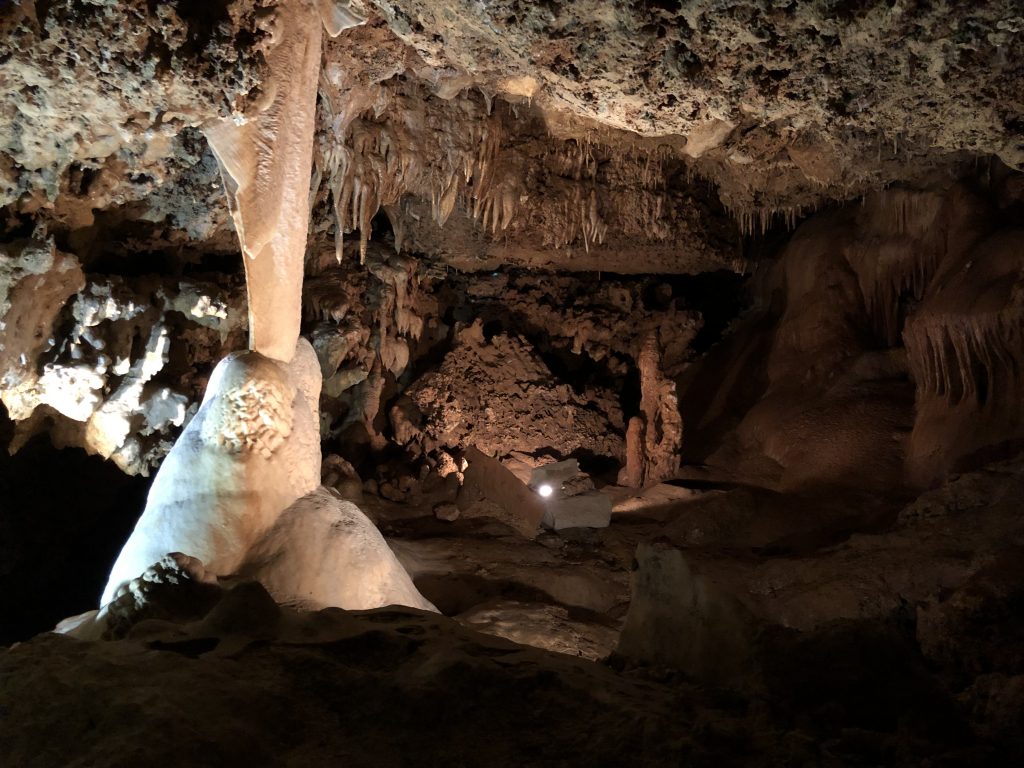Inner Space cavern was discovered by a Texas Highway Department core drilling team in the Spring of 1963. Six inch core samples were taken to determine if the ground was stable enough to support a large highway overpass. As they were drilling one of the test holes, the bit suddenly dropped 26ft. and the highway crew knew there was something down there besides rock. Jack Bigham was the first human to enter the cave; now, directly above the place he descended, is Interstate 35. No worry above a cave-in as there is 33.5 feet of rock between the surface and the roof of the Discovery Room.
In the next few months after discovery, the Texas Speleological Society had secured permission to enter and explore the cave. The first group of spelunkers entered the cave in November 1963. A wooden tripod was erected over the core hole, and each person was lowered down the narrow shaft on a rope tied to an automobile. Within days more than 7,000 feet of cave had been surveyed. Open to the public since 1966, Inner Space Cavern is just a short drive from downtown Austin.
Upon entering the cave you have a photo shoot opportunity, just like entering a cruise ship on the first day. Fun things to see along the way include the Ice Cream Parlour. Of course it’s not real ice cream as this cave, like the others covered in this series, maintain a constant temperature of 70 to 72 degrees. In this room a large stalagmite looks like an ice cream cone, while above it just half an inch apart is the Kissing Column. It is estimated the two will merge into a column in about 50 years.
Unlike Colossal Cave in Tucson, the subject of a future article in this series, Inner Space is a wet cave. In fact, it flooded in 1997, and in 2007 a less severe flood saw water right up to the underside of the balcony in the so-called Castle Balcony room. Largest room in the cave is called the Inner Cathedral, where the University of Texas conducted excavations of fossils from 1965-1970.
You will also see cave art in Inner Space, but it was not done by cavemen thousands of years ago. A UT prof, Dr. Farry, did these in 1966 in the same style as real cave paintings in France. Here you can see a giant ground sloth, a small horse, a sabre-tooth cat and other ancient animals. But there is more than one kind of cave art.

The caves of Texas inspired artist Renée Victor to create a series of images that appear fractal in nature. Her work was on display at the Dougherty Arts Center in Austin from May 10 to June 8, 2019, in an exhibit entitled The Galaxy Wanderer. Victor took photos in the caves with an iPhone, and transformed them into colourful scenes using a photo editing app and Photoshop. The caves of Texas were thus reimagined by her as alien landscapes! The image here shows three of her works on display at the Dougherty.
As a legal alien in the U.S. for many years, writes Victor, she “was constantly reminded of the ways her culture was separate from American culture. The work spotlights human migration and the reality of lines dividing and defining spaces. The current debate on immigration, the border crisis, international travel bans/restrictions and notions of otherness play into this series.” Beyond that Victor wants the viewer to see within the images her homage to space exploration as they reveal the landscapes of worlds yet to be visited.
Photos with this article by C. Cunningham.
This is the second in a series of 4 articles on the caves of Arizona and Texas. A link to the first article is here:
https://sunnewsaustin.com/2020/01/05/natural-bridge-caverns/
Those interested in adding a Victor work to their art collection may contact her directly at this email: artistreneevictor@gmail.com
Inner Space (www.innerspacecavern.com) is located at: 4200 S. I-35 Frontage Rd. Georgetown, TX 78626

